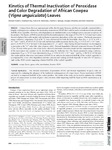| dc.description.abstract | Cow pea leaves form an important part of the diet for many Kenyans, and they are normally consumed after a lengthycookingprocessleadingtotheinactivationofperoxidase(POD)thatcouldbeusedasanindicatorforthepotential shelf life of the vegetables. However, color degradation can simultaneously occur, leading to poor consumer acceptance of theproduct.ThekineticsofPODinsituthermal(forthermaltreatmentsintherangeof75to100°C/120min)inactivation showedabiphasicfirst-ordermodel,withArrheniustemperaturedependenceoftherateconstant.Thekineticparameters using a reference temperature (Tref) of 80°C were determined for both the heat-labile phase (kref = 11.52 ± 0.95 × 10−2 min−1 and Ea of 109.67±6.20 kJ/mol) and the heat-stable isoenzyme fraction (kref =0.29±0.07×10−2 min−1 and Ea of 256.93 ±15.27 kJ/mol). Color degradation (L∗,a ∗, and b ∗ value) during thermal treatment was investigated, in particular as the “a∗” value (the value of green color). Thermal degradation (thermal treatments between 55 and 80 °C per 90 min) of the green color of the leaves followed a fractional conversion model and the temperature dependence of the inactivation rate constant can be described using the Arrhenius law. The kinetic parameters using a reference temperature (TrefC =70 °C) were determined as krefC =13.53±0.01×10−2 min−1 and EaC =88.78±3.21 kJ/mol. The results indicate that severe inactivation of POD (as an indicator for improved shelf life of the cooked vegetables) is accompanied by severe color degradation and that conventional cooking methods (typically 10 min/100 °C) lead to a high residual POD activity suggesting a limited shelf life of the cooked vegetables. | en_US |

